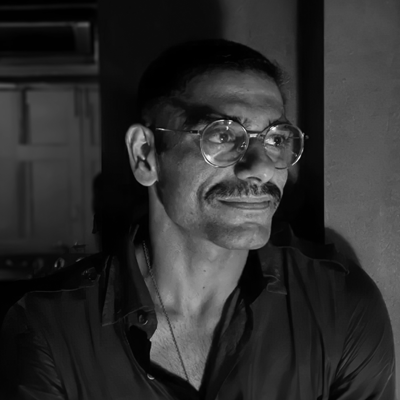The Cosmographical song of creation, the Nasadiya Sukta (Rigveda 10.129) begins with an incantation that wagers that the universe was created ex nihilo.
Darkness was, at first lost in greater darkness.
Neither non-being nor being was then.
There was no air nor the sky above nor the space beyond.
In what was it enveloped and where? In whose keeping?
What Churned in that unfathomable dark?
Neither death nor immortality was then
Nor any sign to divide night from day.
The One who breathed, did so without breath and windless.
There was that One then, and there was no other.
All else was undifferentiated, In that cosmic black.
In that formless void he arose self-created, devoid of creative impulse.
Desire engulfed that one in the beginning,
Desire the germ of that first mind.
Only the arcane wisdom of poets has known
What bonds hold non-being to being.
What was below the umbilical line stretched across, and what above?
Who really knows? who will here declare it?
whence it was born and whence came this creation?
For even the gods came later. Perhaps it created itself, perhaps it did not. That which sees itself
from the highest heaven only, it knows or perhaps it knows not.
The birth of the universe in the Nasadiya Sukta is a tentative one. It refrains from ascribing any intent to our cosmic beginnings. It even contemplates itself to be an error of celestial proportions, unguided by any intelligible hand Divine or otherwise. The possibility of this error is superseded by another. At the Centre of the first darkness lies the cold body of the first man. He is born Svayambhu– he is self-created.
The body of this celestial being arose from the eternal blackness of the first night that reigned before all mornings. And his corpse rots at the centre of the universe, exhaling a black miasma that festers into the present. The cosmic anatomy of this being is the basis of the Indian caste system. His head gives birth to the high caste Brahmin, his Arms become the Kshatriya caste of kings, warriors, skirmishers and second-generation CEOs. His thighs become the Vaishya caste of merchants & trades workers, and finally his feet give birth to the low castes.
The highest are separated from the low, in a cosmic laceration of mind and limb. Consequentially creating a mythological system of oppression aimed towards those who find themselves at the bottom and outside this metaphysical hierarchy. Solely by virtue of birth the lower castes are deemed less than human, and subjected to indescribable aggressions, all in the service of a fairy tale.
In November 1891, Sir James Campbell, the stationed collector of land revenue, customs, salt and opium in Bombay, ominously declared; ‘The unwilled is spirit-caused in the Presidency’.
During the Colonial Raj, diseases were said to be the work of trickster demons, malevolent ghosts and wrathful goddesses. These spectral forces were believed to arise from the same terrain of abjection that was forced upon those who found themselves at the bottom of the caste hierarchy.
The persistence of this belief in the Bombay presidency during the onslaught of cholera, small-pox and the Bubonic Plague, gave rise to its own spectral inverse. One that threatened, however briefly, to upstage the violent metaphysics of caste. It began with a rumour, a secret that spread as fast as the clutch of the Plague itself; the lower castes could negotiate with the disease gods, coax them, charm them and through rituals of possession and exhumation, drive them out from the bodies of men.
The ritual begins with the burning of incense before the exorcist. Drums are beaten. The exorcist raises a burning wick in one hand, and a broom made of peacock feathers in the other, and begins a vigorous dance to frighten the spirit possessing the diseased person. He cries out loudly, drawing the evil spirit from the body of the patient and captures it in a bottle that is either carried out of the village and buried under an old tree or cast into the depths of the Arabian Sea.
If the disease demon is too strong to be contained in mere glass, the exorcist offers up their own body for possession. This possession begins with songs of summoning that are performed with the slow but loud beating of a leather drum. The exorcist prepares their own body for possession by bathing and sitting on a small prayer carpet, with a bowl of rice on one side and a copper pot filled with water on the other. As the drum beats, they slowly begin throwing grains of rice into the pot, pronouncing the name of the spirit that has afflicted the patient with disease and their reasons for doing so. Next, they begin their dance, shaking as if in a fit, hurling abuses at the spirit and threatening it repeatedly, growing louder and frenzied till their words and movements become an illegible turbulence of noise and fury.
It was not uncommon to see the patients themselves partake in the chaos of the ritual. The afflicted would rise from their sickbeds to dance or sing or cry inconsolably. Some are seen to violently throw their fists to the air, attacking the invisible demons, while others are known to stand solemnly making long oratory speeches, locking their afflictions in debate.
Share this:
- Click to share on Facebook (Opens in new window) Facebook
- Click to email a link to a friend (Opens in new window) Email
- Click to share on X (Opens in new window) X
- Click to share on LinkedIn (Opens in new window) LinkedIn
- Click to share on WhatsApp (Opens in new window) WhatsApp
- Click to share on Telegram (Opens in new window) Telegram


